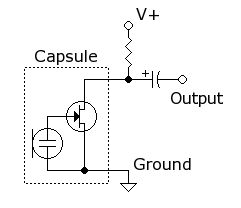I tried using a 100nf ceramic capacitor for this and got no or close to no audio signal on the output. Then I tried using an electrolytic cap and it worked way better, although it was only better on certain electrolytic caps for some reason.
You must account for impedances at various points in the circuit. A small 100nF capacitor probably has an impedance much too high at lower audio frequencies, and that is why the audio signal sounded "thin". So using a larger-value capacitor (0.1uF or 1 uF or 10uF) is more appropriate for full-range audio. Depending, of course, on the impedance of the circuit at that point.
Also, what way around do I put the capacitor in the circuit? (polarity)
Typically you put the + side on the side of the circuit that has a higher DC voltage.
How important is component value choice in a circuit?
In some places, you can get away with 2x or even 5x difference in value. But in other parts of the circuit even a 10% difference in value will significantly shift the operation of the circuit. Quite possibly to the point where it won't operate properly.
Where do I buy components? I have been buying from ebay, but I don't know if that is a good idea or not.
I have bought several resistor and capacitor "kits" (collections of several popular values) from Chinese sellers.
The major downside is delivery time. But probably faster delivery to you there in NZ than to me here in the US.
Isn't a capacitors job to amplify, have a high output than input.
No, absolutely not. Capacitors, resistors and inductors are PASSIVE components. They are not capable of amplification.
Did you mean to say "transistor's job"?
But when I measure the difference in voltage between the base of the transistor and the output, it's always lower. I even did a test where the independent variable was the input voltage which goes to the base of the transistor which started at 0.1v, and went up in 0.1 of a volt until 5v. The dependent variable which is the output voltage of the transistor circuit was almost completely relative to the input voltage, a completely linear increase. Now I have seen the characteristic curve of a transistor, and I know that it is not supposed to be linear. Can someone please explain?
You can't just pick drive, bias and load resistors for a transistor stage at random. You must operate the transistor within its linear range to get analog amplification. Download the data sheet for your transistor and study all those curve diagrams.
Here is a data sheet for your BC547 transistors:
https://www.fairchildsemi.com/datasheets/BC/BC547.pdfNote particularly Figure 1 on page 3.
Watch some YouTube videos on how junction transistors work and how to bias them.
Remember that junction transistors are CURRENT DEVICES. The Emitter-Collector CURRENT is proportional to the Base-Emitter CURRENT.
Is an electret mic essentially a variable capacitor? Whereby when you speak it oscillates the diagram in the microphone changing the capacitance of the microphone, just confirming. My question is, how does putting this across a battery in series with a resistor make a varying current or voltage? Also does the microphone its self have any internal circuitry, because I read somewhere that they a small amplifier inside them?
An electret condenser microphone CAPSULE as you are using is actually a condenser microphone ELEMENT, permanently charged by an ELECTRET layer, and with an IMPEDANCE BUFFER circuit INSIDE the little case. Here is a diagram showing the INTERNAL circuit of the mic capsule, along with a typical output (external) circuit. The resistor "powers" the FET transistor INSIDE the capsule, and the capacitor "taps off" the AC audio signal from the bottom of the resistor.

Suggested reading:
https://en.wikipedia.org/wiki/Electret_microphone